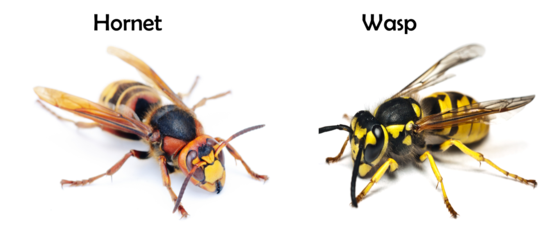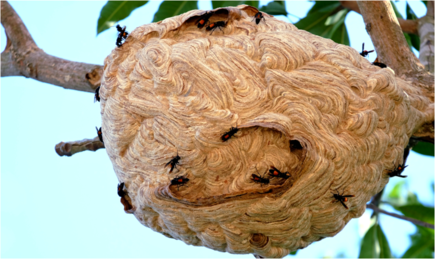|
Wasps and Hornets  Wasps, hornets, and bees all pollinate plants and flowers, keeping the natural world green and growing. They can be beneficial to keeping your property looking great, but they can also carry a nasty sting. Stinging insects, although environmentally beneficial, should not be near your family, business, or patrons. Hornets, however, present a significant risk to humans and pets when a colony is near a house, business, or public area. Hornets have stingers used to kill prey and defend the nest. Hornet stings are more painful than wasp stings because hornet venom contains a large amount of acetylcholine (approximately 5%), though the toxicity varies by species. Hornets will sting multiple times and can mobilize the entire nest to sting in defense. If a hornet is killed near the nest, it may release an attack pheromone that bonds to materials it reaches. Hornets are dangerous and should be dealt with only by professionals.  We highly advise homeowners not to remove stinging insect nests, especially the large paper nest. The wasps and hornets living in those can be very aggressive and we do not want you to get injured. Sadly, we have had several clients call us after a loved one has been rushed to the ER after stumbling across wasp nests or trying to remove the nests by themselves. The National Pest Management Association reports that stinging insects send more than half a million people to the emergency room every year. Those with allergies to stings are most at risk, although anyone can be affected if a large number of stinging insects swarm and sting at once. We recommend giving us a call to help you with all your stinging insect problems. All of our trained technicians are fully equipped with proper protective gear to safely remove nests. Typically, stinging insects require only a one-time visit to remove the nest(s) and spray the areas to prevent other stinging insects from building in that location. Our spot treatments are one of our very popular forms of pest control, especially when it comes to yellow jackets and wasps. Our goal at Custom Pest Solutions is to make sure your pest control problems are taken care of as quickly as possible. How long after an insect or wasp sting can an allergic reaction or anaphylaxis occur? An allergic reaction may occur immediately or within four hours of an insect sting. A severe allergic reaction, called anaphylaxis, often begins within minutes of the insect sting, but occasionally may begin an hour or so later. Are Wasps beneficial in any way? Wasps and yellow jackets are beneficial insects. They feed their young on insects that would otherwise damage crops and ornamental plants in your garden. They can also feed on house fly and blow fly larva. Wasps and yellow jackets become aggressive when their nests are approached or disturbed. |
|
|
 |
